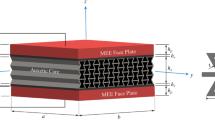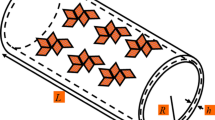Results of experimental investigation of the spectrum of optical constants of a glassy carbon produced in Russia and of mathematical simulation, with them, of the spectral, kinetic, and thermophysical characteristics of composite reticular materials based on this carbon are presented. The investigations were performed with compacted samples of a composite reticular glassy carbon identical in physical properties to the glassy carbon forming the basis of highly porous cellular materials. By the hemispherical radiant reflectivity of these samples, illuminated at a right angle, the spectra of optical constants (the refractive index and the absorption coefficient) of the glassy carbon forming their basis were determined using the Kramers–Kronig relations, and a number of spectral characteristics of the composite reticular glassy carbon, related to these constants, were calculated by the simple approximate relations derived by us. The thickness of the skin layer in the samples of this composite was estimated, and some features of the interaction of the material of their fragments with an electromagnetic radiation were determined. The data on the spectral characteristics of the composite reticular glassy carbon were integrated into the statistical model developed earlier on the basis of the exact electromagnetic theory for simulating the optical properties of reticular materials having an ultrahigh porosity. This model allows one to estimate the features of the microstructure of such a material and the physical processes proceeding in it at different spatial and time scales. Results of calculations of the spectral and kinetic coefficients of the radiative transfer equation, the scattering indicatrix, the heat radiative conductivity, and the total heat conduction of the composite reticular glassy carbon are presented. The possibilities of the model proposed are demonstrated.
Similar content being viewed by others
References
A. G. Shchurik, Artificial Carbon Materials [in Russian], Izd. Permsk. Gos. Univ., Perm’, (2009).
A. G. Shchurik, Method of Obtaining a Cellular Carbon Material, RF Patent No. 2089494 (1997).
J. W. Klett, Process for Making Carbon Foam, United States Patent No. 6033506 (2000).
Reticulated Vitreous Carbon Foam, Data of the firm “Ultramet” (USA); https://ultramet.com/refractory-ope-cee-foams/reticulated-vitreous-carbon-foam.
A. G. Shchurik, S. V. Dokuchaev, and V. A. Petrov, Verification of the possibility of change in the properties of highly porous cellular carbon materials containing nanotubes, in: Proc. Int. Sci.-Tech. Conf. “Actual Problems of the Powder Material Science,” November 26–28, 2018, Izd. Permsk. Nats. Issl. Politekh. Univ., Perm’ (2018), p. 522.
O. M. Alifanov and V. V. Cherepanov, Methods of Investigating and Forecasting the Properties of Highly Porous Heat-Insulating Materials [in Russian], Izd. MAI, Moscow (2014).
O. M. Alifanov, V. V. Cherepanov, and A. V. Morzhukhina, Mathematical modeling of ultraporous nonmetallic reticulated materials, J. Eng. Phys. Thermophys., 88, No. 1, 124–133 (2015).
A. G. Shchurik, Results of compaction of a highly porous carbon by an isothermal method, in: Proc. Int. Sci.-Tech. Conf. “Actual Problems of the Powder Material Science,” November 26–28, 2018, Izd. Permsk. Nats. Issl. Politekh. Univ., Perm’ (2018), p. 516.
F. C. Jahoda, Fundamental absorption of barium oxide from its reflectivity spectrum, Phys. Rev., 107, No. 5, 1261–1265 (1957).
J. L. Musfeldt, D. B. Tanner, and A. J. Paine, Method for the determination of the optical properties of highly conjugated pigments, J. Opt. Soc. Am. A, 10, No. 12, 2648–2657 (1993).
C. F. Bohren and D. R. Huffman, Absorption and Scattering of Light by Small Particles, Wiley, New York (1998).
L. J. Van der Pauw, A method of measuring specific resistivity and Hall effect of discs of arbitrary shape, Phillips Res. Rep., 26, No. 8, 220–224 (1958).
G. W. Kaye and T. H. Laby, Tables of Physical and Chemical Constants and Some Mathematical Functions, Longmans, Green & Co, London, New York, Toronto (1911).
V. V. Cherepanov, Interaction of radiation with fragments of a highly porous material. Theory, Teplovye Protsessy Tekh., 3, No, 5, 215–227 (2011).
O. M. Alifanov and V. V. Cherepanov, Nonsingular model of the interaction of radiation with representative elements of highly porous materials, Mat. Model., 24, No. 3, 33–47 (2012).
V. V. Cherepanov, O. M. Alifanov, A. V. Morzhukhina, and A. V. Cherepanov, Interaction of radiation with orthogonal representative elements of highly porous materials, Appl. Math. Model., 40, Nos. 5–6, 3459–3474 (2016).
B. L. Drolen and C. L. Tien, Independent and dependent scattering in packed spheres, AIAA J. Thermophys. Heat Transf., 1, No. 1, 63–68 (1994).
M. I. Mishchenko, Scattering of Electromagnetic Radiation in Random Dispersive Media, Doctoral Dissertation (in Physics and Mathematics), Kiev (2007).
V. V. Cherepanov and O. M. Alifanov, Modeling of spectral properties and the phase scattering function for a lightweight heat protection spacecraft materials, ASME J. Heat Transf., 139, No. 3, 032701 (2017).
Author information
Authors and Affiliations
Corresponding author
Additional information
Translated from Inzhenerno-Fizicheskii Zhurnal, Vol. 93, No. 3, pp. 732–741, May–June, 2020.
Rights and permissions
About this article
Cite this article
Alifanov, O.M., Cherepanov, V.V., Shchurik, A.G. et al. Calculation of Characteristics of Reticular Materials based on a Glassy Carbon by its Optical Constants Determined Experimentally. J Eng Phys Thermophy 93, 710–718 (2020). https://doi.org/10.1007/s10891-020-02170-z
Received:
Published:
Issue Date:
DOI: https://doi.org/10.1007/s10891-020-02170-z




